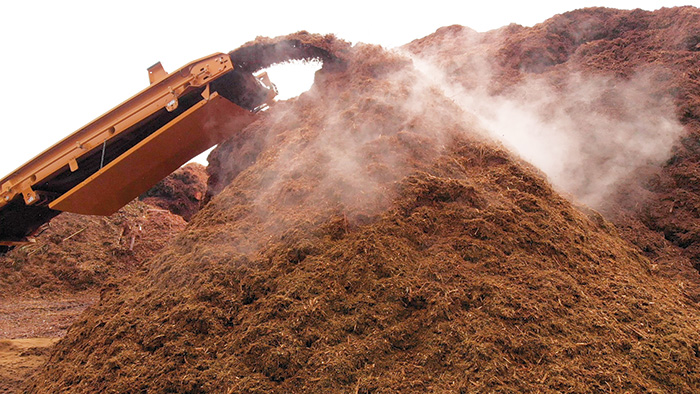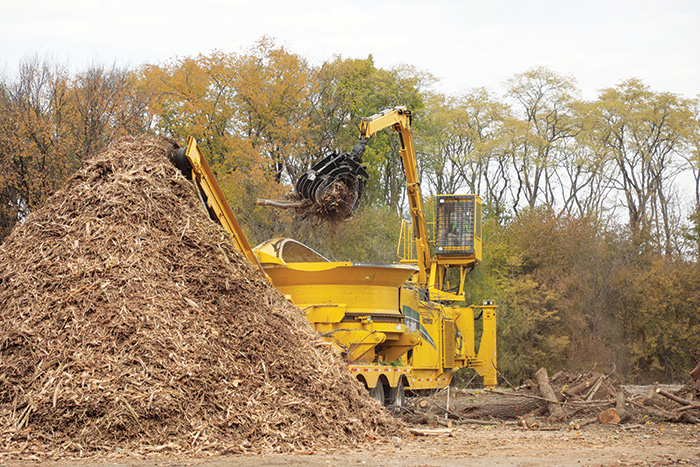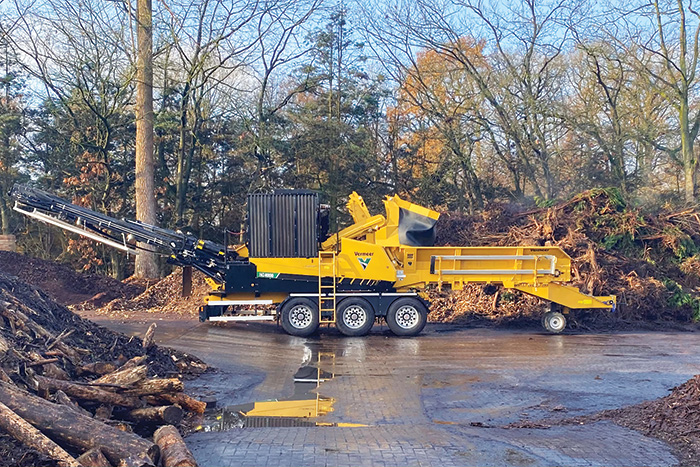Defining organic and processed wood waste and how to choose the right equipment.
By Ted Dirkx
Recycling is becoming a common practice at most public and private waste handling facilities. In fact, recycling organic wood waste is how many facilities started. Today, recycling wood waste, organic and processed, is not just a landfill space saver—it is also a revenue stream for many organizations.
To make wood waste a revenue stream area of your waste facility, you need to make sure you optimize your process. That starts with identifying what method of processing needs to be employed for the type of material being collected and determining the appropriate equipment to reduce the size of the material.

Defining Wood Waste—Organic and Processed
By definition, wood waste includes all wood and wood-based products, including organic plant material (trees, plants, yard material, etc.) and processed wood material (lumber, plywood, etc.). These materials become waste when they outlive their usefulness or come to the end of their lifespan. To help reduce stress on the nation’s landfill facilities, it is critical to develop sustainable practices to process and reuse wood waste.
There are many benefits to recycling wood waste. For example, by recycling wood and plant-based material, waste gets a second life where it can provide valuable nutrients for plants, cover for landscaping, and fuel.
Compost, mulch, and biofuel/biomass are the three biggest markets for recycled wood waste material. Still, smaller market opportunities are also viable with some additional processing, including animal bedding, paper, and pressed lumber.
Through wood waste recycling, the number of trees harvested each year is reduced, and unnecessary waste is eliminated from landfills. It also helps reduce energy costs, and repurposed wood material delivers a natural fertilizer for plant development.
However, not all wood waste is the same. For example, organic material is a much cleaner resource than processed wood waste because there are significantly fewer contaminates mixed in with the material—reducing the number of steps, as well as costs involved, with the recycling process.

Organic Material Types
Organic waste comes in many shapes and material types, but at the heart of the organic recycling process is a carbon source mainly comprised of wood. The most common sources of organic wood waste are trees that have been cut down or damaged during a weather event. Natural disasters, such as storms, tornados, hurricanes and ice storms, can be devastating, but downed trees play an instrumental part in replanting and rebuilding.
Other Forms of Organic Material Recycling
While most of the organic material comes from trees, other commonly recycled organic materials include:
• Leaves
• Grass clippings
• Shrubs
• Garden and landscaping plants
• Plant-based food scraps
Non-Organic Wood Waste Recycling
Processed wood material can also be recycled. However, because there is a greater chance of contaminates in this material than with organic material, you should consider keeping it separate from organic wood waste. Many processed wood materials can be reused to make pallets and biomass for fuel, but since it does not break down as quickly as organic material, it is best not to use processed wood for compost. Some common processed wood material comes from:
• Lumber
• Pallets
• Building material
Exploring the Equipment Used to Recycle Wood Waste
Sizing wood waste is a critical step in the wood waste recycling process. Many potential retail markets demand material within specific size ranges, such as:
• Compost—Under 4 inches (10.2 cm) in length and width
• Mulch—1-1/2 inches to 2-1/2 inches (3.8 cm to 6.4 cm)
• Biomass/biofuel—Varies by burner type and size
High-speed grinders, low-speed shredders and screening equipment are the most widely used machinery to size collected wood waste material. A grinder or a shredder is used to reduce the volume of collected material, while screening equipment, like trommel screens, is used to separate various sizes of material.

Grinding Equipment Types
The three most widely used machines for processing wood waste material are high-speed horizontal grinders, high-speed tub grinders and low-speed shredders. Determining which machine type to use depends on the incoming material type, size and shape, facility location and the kind of end product being produced. For example, tub and horizontal grinders are most often used for processing organic wood waste because they can reduce material to smaller sizes faster and more efficiently than most shredders. However, shredders are a viable option for recycling operations and handling processed wood material, as well as other building materials and debris.
Horizontal Grinders Advantages
Horizontal grinders are efficient at handling longer material. So, if you receive a lot of long-cut tree branches and limbs, using a horizontal grinder can help reduce the cutting time before processing material through grinders. Horizontal grinders are also good at handling loose green waste.
Tub Grinder Advantages
Tub grinders can handle bulkier materials like tree stumps, as well as processed wood material like pallets. Tub grinders use gravity instead of conveyor belts to feed the hammer mill, so there are fewer moving components on a tub grinder than a horizontal grinder. Tub grinders are efficient at processing loose green materials.
Shredder Advantages
Low-speed shredders neither have the same production levels as grinders nor are they as effective at sizing materials, but they are typically more tolerant when processing material with many contaminates. To achieve the appropriate end product size, many facilities use shredders to pre-size material containing contaminates, like building materials, and then use a grinder to achieve the desired final sizing.

Sorting and Separating Equipment
Depending on the end product being produced, sorting and separating machinery may also need to be employed. Screen equipment is widely used for making compost and for some biomass/biofuel types. To achieve high-quality products, you may also need to add a contaminate separator or air separator to remove plastic from processed material.
Screening Equipment
While options for screening include deck screens as well as disc and star screens, trommel screens are the preferred method at many facilities because of their efficiency and ease of maintenance. Compared to disc and star screens, trommels do not require much maintenance because the technology relies heavily on gravity to move and screen material versus more mechanical means.
The industry offers two configurations of trommel screens—a tensioned screen drum or an auger drum. Trommels with a tension screen drum use a lift-and-throw action to separate material. As compost is cycled through the drum, the smaller material passes through the screen’s holes while larger material exits at the end of the trommel. The slope of the machine dictates the rate at which the material flows through the drum as it is tumbled. Using tensioned woven-wire screen panels allows the use of smaller gauge wire to increase the total open screen area, which helps maximize production.
Trommels with an auger drum separate material using tumbled-roll action, which reduces the chance of material spearing the screens. However, auger drums have less open surface area and are more prone to having wet material build up in the drum, and it may be more expensive to change product size due to needing an additional drum.
A Sustainable Future
By understanding the available options for handling wood waste and implementing efficient recycling practices, organizations can contribute to a sustainable future while also generating revenue.
| WA
Ted Dirkx is the Sales Manager for Environmental Equipment at Vermeer. After studying composting and graduating with a degree in Environmental Studies from Central College, he joined equipment manufacturer Vermeer Corporation in Pella, IA. For the past 11 years, he has been traveling about 25 weeks a year, roaming North America and beyond, helping organizations set up compost facilities, manufacture mulch, clear land, and produce biofuels. As he interacts with operations, he is a curious learner of all things that make their operations successful. He has presented at the Compost Council of Canada Conference, Canadian Wood Waste Recycling Association, Waste Expo, and USCC Conference on topics related to operational efficiency and maintenance. Ted can be reached at [email protected].
Vermeer Corporation reserves the right to make changes in product engineering, design and specifications; add improvements; or discontinue manufacturing or distribution at any time without notice or obligation. Equipment shown is for illustrative purposes only and may display optional accessories or components specific to their global region. Contact your local Vermeer dealer for more information on machine specifications.
Vermeer and the Vermeer logo are trademarks of Vermeer Manufacturing Company in the U.S. and/or other countries.
© 2024 Vermeer Corporation. All Rights Reserved.
